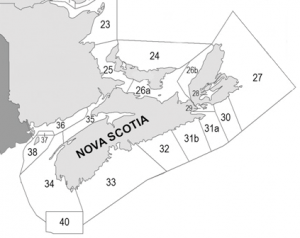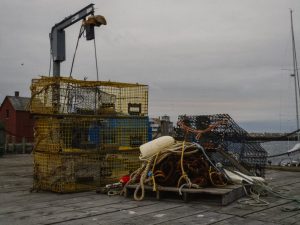Problems that arise in the real-world allow for meaningful classroom discussions about social issues. Currently in Nova Scotia, there is an ongoing debate between Mi’kmaw and non-Indigenous fishers about the rules around when lobsters can be harvested. A lot of the confusion stems from the 1999 Marshall Decision made by the Supreme Court of Canada which maintained a treaty right to hunt, fish, and gather in pursuit of a ‘moderate livelihood’, arising out of the Peace and Friendship Treaties of 1760 and 1761. In particular, different interpretations of the phrase ‘a moderate livelihood’ have led to great conflict about how Indigenous and non-Indigenous fishers can share the resource.
This issue can be explored through many different lenses, including from a math or science perspective. But before examining the ways math and science can enhance understanding, it is first necessary to teach about the broader context in which the conflict is situated. In this case, it involves learning about the Indigenous treaty rights associated with the Mi’kmaw community and the broader historical and current relationships between Indigenous and non-Indigenous peoples. Bringing social issues into the classroom takes time and commitment. This issue is complex and will require sustained efforts over time to adequately unpack. Without first understanding the social/political/historical context, the math and science learning will be limited.
Resources to understand the contextual background between Mi’kmaw and non-Indigenous Fishers
Read the story of Donald Marshall and his fight to maintain his Treaty Rights
Read the Peace and Friendship Treaties
The fishing issue explained by Mi’kmaq Chiefs
Learn about the Mi’kmaq Rights Initiative
Math and science skills are fundamental to understanding a range of social issues. In the case of Mi’kmaw and non-Indigenous fishers, there are a range of ways math and science can enhance understanding of the issue and allow students to form critical opinions. This is particularly important as children in the junior grades become more and more aware and invested in exploring real-world issues of justice.
Studying the lobster
The importance of conservation is a key argument in the lobster fishery debate. In order to better understand some of the issues that impact the sustainability of the lobster, students should study the life cycle, habitat, and anatomy of the lobster. This will help students better understand the species and the environmental factors that affect conservation efforts.
Check out these two resources: an indigenous plan for managing the Atlantic lobster and a Thesis on Mi’kmaq resource management.
Using maps and investigating catch rates to understand lobster abundance in Nova Scotia waters
Once students better understand the species, they can explore the interaction between lobsters and fishers. One excellent way to do this is to use maps to explore the spatial distribution of lobster in different water areas surrounding Nova Scotia. Maps also offer an opportunity to draw attention to where the Mi’kmaq live in relation to non-Indigenous people in Nova Scotia. Fishing has been – and continues to be – vital to the lives of Indigenous Mi’kmaw people since well before the area was colonized by Europeans. A recent article in the Toronto Star (2019) interviewed Alanna Syliboy of the Mi’kmaw Conservation Group who said that a two-eyed seeing approach (using both Indigenous and Western knowledge) will only benefit fisheries. However, it is important to keep in mind that Indigenous voices need to be included from the beginning, not as an afterthought as so often has happened in the past.
There are many ways to measure the abundance of lobsters. One way abundance of lobsters has been measured in Nova Scotia is by using Catch-per-unit-effort (CPUE) or catch rate. This is a quantitative index describing how many lobsters of a certain size are caught per trap. In the following lesson, students explore the spatial patterns of lobster abundance in different water areas surrounding Nova Scotia.

Simulating sharing resources
Students may also be wondering about how lobster, a common resource, is managed and shared. One of the major concepts in the area of conservation is addressing the Tragedy of the Commons, a theory that states when a community shares a common resource people tend to make decisions in their own self-interest as opposed to considering the impact on the group (Hardin, 2009). This results in the depletion of the resource. In order to avoid the depletion of resources, communities must make rules about how to manage supply so that everyone can have a fair share while ensuring the sustainability of the resource. According to the federal government, Mi’kmaw communities have the right to make a living from fishing so long as conservation is maintained. Prior to colonization, Indigenous nations governed resources based on a reciprocal relationship with the land. Indigenous people developed their own guidelines to ensure fair distribution and healthy resources for the future. Conservation of the lobster to avoid a Tragedy of the Commons is a key issue in the Nova Scotia lobster debate.
This lesson explores what happens when individuals act only in their best interests to get the greatest number of fish. The simulation will allow students to see the different possibilities of working together to conserve resources.
Moving forward…
Interviews with both Indigenous and non-Indigenous fishers say collaboration is necessary in resolving the fishery issue in Nova Scotia (Goodyear, 2020; Minke-Martin, 2020; CBC News, 2020). Co-management of resources is made even more complicated because of colonial history. While math and science provide one perspective on the issue, there are also ethical concerns such as upholding Indigenous Treaty Rights that also need to be taken into consideration. These ethical decisions may go beyond mathematical and scientific solutions to the problem.
Have you explored Mi’kmaw and non-Indigenous fisheries in Nova Scotia with your class?
We want to hear from you! Please email robertson@utoronto.ca or message us on twitter @robertsonprog to share your ideas!
Author

Larisa Lam
Program Director for the Robertson Program for Inquiry-based Teaching in Mathematics and Science
References
Goodyear, S. (2020). N.S. fishermen’s union head quits, says lobster dispute is ‘too much of a toll’ on his family. CBC Radio. https://www.cbc.ca/radio/asithappens/as-it-happens-the-friday-edition-1.5765309/n-s-fishermen-s-union-head-quits-says-lobster-dispute-is-too-much-of-a-toll-on-his-family-1.5765312
Hardin, G. (2009). The tragedy of the commons. Journal of Natural Resources Policy Research, 1(3), 243-253.
Hatcher, A., Bartlett, C., Marshall, A., & Marshall, M. (2009). Two-eyed seeing in the classroom environment: Concepts, approaches, and challenges. Canadian Journal of Science, Mathematics and Technology Education, 9(3), 141-153.
A Mi’kmaw chief on pressing ahead with moderate livelihood fishery despite protest. (2020). CBC News. https://www.cbc.ca/news/canada/nova-scotia/nova-scotia-lobster-fishery-mi-kmaq-moderate-livelihood-chief-mike-sack-1.5726191
Minke-Martin, V. (2020). Mi’kmaw Fishery Dispute Is Not About Conservation, Scientists Say. Hakai Magazine. https://www.hakaimagazine.com/news/mikmaw-fishery-dispute-is-not-about-conservation-scientists-say/
Seiden, J. M., Wilke, K. M., & Schneider, D. C. (2013). Spawning odds in relation to size of American lobsters Homarus americanus. Journal of Shellfish Research, 32(3), 779-783.






